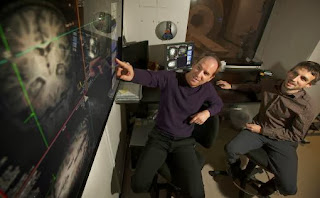Myelin is an insulating material that forms a sheath around
the axon of neurons. The material increases the speed of impulses in the brain
and the spinal cord. The increase of myelin is part of the maturation and
development of language. In theory, the more sheath, the messages are sent more
rapidly and therefore children have more language abilities.
A link between language and the frontal left cortex has been
established for many years. As part of my EPQ, I conducted a dichotic listening
experiment to investigate this further and concluded that over 80% of my
subject has specialisations in their left hemisphere. Due to this link,
scientists expected to find more myelin in the frontal left hemisphere. As hypothesised,
they did discover that the levels of myelin were asymmetric as the left
hemisphere has a denser amount of myelin. However, the study shows that the
levels of myelin increased at the same rate in both hemispheres from the age of
1 – showing that the increased amount of myelin was already there. This shows
that the amount of myelin may not account for the increased language ability in
children, but shows the importance of the child’s environment.
The scientists also found that the myelin had a stronger
influence on language until they were 4 years old and that after the 4 year old
marker, the levels of myelin remained mostly constant. This explains how
children learn their first language so quickly and how children are more able
to become fluent in a second language than an adult. This suggests that there
is a ‘critical period’ (Chomsky) for language. This also sheds a new light on
Piaget’s theory of the different developmental stages that children go through.
The first two are:
·
Up to 2 years old - sensory motor stage
·
2-7 years old - preoperational from stage
Piaget specified that the first stage depends greatly on
social environment and exposure to language so the brain begins to become asymmetrical.
If a child is in the right environment, the frontal lobes increase in size
greatly. During the next stage, both Wernicke’s and Broca’s area are said to
develop most, however the brain growth slows down after half way through this stage.
These hypotheses are reinforced to a certain extent by this
new research, showing that the environment that children grow up in are very
important, that the brain develops (as the levels of myelin increase) and that
the critical period for language is about four years old.
As quoted from Dr Sean Deoni from Brown University:
"This work is important as it is the first to investigate the relationship between brain structure and language across early childhood and demonstrate how this relationship changes with age."To read more visit: http://news.brown.edu/pressreleases/2013/10/language

No comments:
Post a Comment